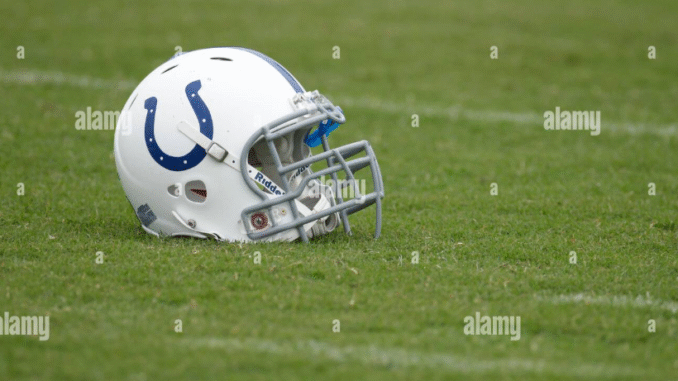
Quarterbacks
Anthony Richardson, Daniel Jones, Riley Leonard, Jason Bean
Even with veteran Daniel Jones signed in free agency, this is still Anthony Richardson’s job to lose. Now entering his third season, it’s a make-or-break year for the potential franchise quarterback. Richardson must prove himself both on and off the field—displaying improved leadership, a strong work ethic, and, most importantly, staying healthy. If he can become a consistent presence under center, the Colts’ offense could reach elite levels. That said, there’s an intriguing mismatch between Richardson’s skillset, which thrives in a gunslinger-style offense, and the current system that seems more suited for a game-managing quarterback—a deeper discussion for another day.
Daniel Jones is tough to evaluate. A former first-round pick who never quite lived up to expectations, he has 2,979 yards, 10 touchdowns, and 13 interceptions in his last 16 starts. Released midway through last season, he ended the year on the Vikings’ practice squad. His ceiling is likely as a veteran backup.
Riley Leonard was brought in to replace Sam Ehlinger as the developmental third option. Leonard’s preseason reps will be worth watching, especially given the injury and inconsistency histories of the quarterbacks ahead of him. However, he could benefit from a couple of seasons on the bench to fully develop his game.
Running Backs
Jonathan Taylor, Khalil Herbert, DJ Giddens, Tyler Goodson
Jonathan Taylor looks primed for a comeback campaign after a strong finish to last season—excluding a brutal dropped touchdown against the Broncos, which arguably cost the Colts a critical win. Over the final three games, Taylor tallied 520 yards and six touchdowns, re-establishing himself as the team’s workhorse.
Khalil Herbert and DJ Giddens are clear upgrades over last year’s backup Trey “Yard-per-carry” Sermon. Goodson fills the role of a pass-catching specialist, though ironically, his drop on fourth down versus the Texans ranks among the Colts’ worst moments of the past year. Herbert brings proven production, and Giddens could shine if thrust into a bigger role due to injury. Still, the team is heavily reliant on Taylor’s health, and another veteran addition wouldn’t have hurt.
Tight Ends
Tyler Warren, Jelani Woods, Mo Alie-Cox, Andrew Ogletree, Will Mallory
Tyler Warren falling to the Colts at #14 was a stroke of luck. He fills a major hole in the offense and projects as one of the most pro-ready tight ends in recent draft classes, second only to Brock Bowers. He should immediately take over as the TE1, ending last year’s “by committee” approach.
Jelani Woods remains an enigma—flashes of brilliance as a rookie were followed by a season-ending injury in 2023 and a hamstring issue that kept him sidelined all last year. When healthy, he’s a matchup nightmare in the red zone and a solid blocker, but availability remains the big question. Ogletree and Mallory provide depth, though they’ll likely only see situational usage. Ogletree’s blocking ability gives him the edge for snaps over Mallory.
Wide Receivers
Michael Pittman Jr., Josh Downs, Alec Pierce, AD Mitchell, Ashton Dulin, Anthony Gould
Michael Pittman Jr. remains the WR1 but is coming off his least productive season since his rookie year—69 catches for 808 yards and three scores. A back injury, inconsistent quarterback play, and reduced target share contributed to the drop-off.
Meanwhile, Josh Downs and Alec Pierce stepped up. Pierce emerged as the league’s top deep threat, averaging a league-best 22.3 yards per catch on 37 receptions for 824 yards and seven touchdowns. Downs posted 72 receptions, 803 yards, and five touchdowns—despite playing significantly fewer snaps than both Pittman and Pierce.
AD Mitchell had a disappointing rookie year. While he frequently got open, issues with drops, avoiding contact, and missed opportunities from Richardson held him back. With Pierce solidifying his role, Mitchell must prove why he was worth a second-round pick. Dulin and Gould are likely relegated to special teams duty unless injuries strike. Gould, in particular, must reclaim his return role after losing it to Downs last year.
Offensive Line
Bernhard Raimann, Quenton Nelson, Tanor Bortolini, Matt Goncalves, Braden Smith, Blake Freeland, Jalen Travis, Dalton Tucker, Danny Pinter, Wesley French, Josh Sills, Atonio Mafi
This unit saw the most change in the offseason. Two new starters are set to join a group that regains a key piece in right tackle Braden Smith, who returns after a personal leave. The left side is solid with emerging star Bernhard Raimann and All-Pro Quenton Nelson. With Ryan Kelly gone, second-year center Tanor Bortolini steps in after impressing as a rookie. At right guard, Matt Goncalves shifts inside from swing tackle—a move many anticipated post-draft—and lines up next to Smith. If everyone stays healthy, this could be a top-10 unit.
Depth, however, is a concern. Blake Freeland will compete with rookie Jalen Travis for the swing tackle job. Freeland struggled mightily last year, though he faced elite pass-rushers and deserves some leniency. Even if Travis doesn’t win the battle, he may offer valuable interior flexibility—a necessity given the team’s lack of depth there.
Dalton Tucker was so ineffective last year that the Colts turned to veteran Mark Glowinski midseason. Danny Pinter is a decent backup center but unplayable at guard, while Wesley French will battle him for the No. 2 spot. Josh Sills brings little experience, and Atonio Mafi graded as one of the NFL’s worst guards in his last active season (2023), per PFF.

Leave a Reply